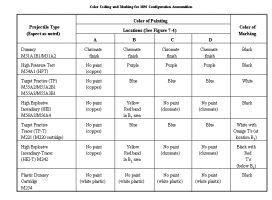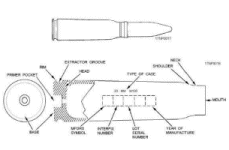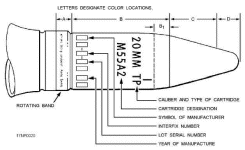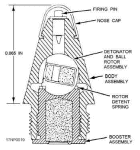M50 Family
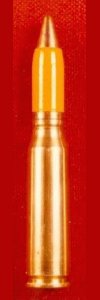 Aircraft gun ammunition is developed for specific types of aircraft-mounted guns. The M61A1/A2 initially used M50/PGU series 20-mm ammunition. The M50/PGU series consists of various types of cartridges developed for specific applications, including test cartridges, dummy cartridges, target practice, target practice tracer, armor piercing incendiary, high-explosive incendiary, and semi-armor piercing, high-explosive incendiary. Blank and dummy rounds are also used for practice and maintenance. The M50/PGU series 20-mm ammunition is loaded into the M61A1/A2 gun through the linkless ammunition loading system (LALS) series. The LALS transports rounds from the transporter to the aircraft system, and simultaneously transports spent cases and cleared rounds from the aircraft system to the transporter.
Aircraft gun ammunition is developed for specific types of aircraft-mounted guns. The M61A1/A2 initially used M50/PGU series 20-mm ammunition. The M50/PGU series consists of various types of cartridges developed for specific applications, including test cartridges, dummy cartridges, target practice, target practice tracer, armor piercing incendiary, high-explosive incendiary, and semi-armor piercing, high-explosive incendiary. Blank and dummy rounds are also used for practice and maintenance. The M50/PGU series 20-mm ammunition is loaded into the M61A1/A2 gun through the linkless ammunition loading system (LALS) series. The LALS transports rounds from the transporter to the aircraft system, and simultaneously transports spent cases and cleared rounds from the aircraft system to the transporter.
By 2006 General Dynamics Ordnance and Tactical Systems had supplied over 150 million High Explosive Incendiary (HEI) M56 and Target Practice (TP) M55 cartridges to world wide users of 20mm x 102 gun systems. The M56 and M55 cartridges are fully interoperable in aerial and surface platforms using the M61 and M197 gun systems. General Dynamics Ordnance and Tactical Systems also supply companion M200 series HEI and TP tracer ammunition.
M50 configuration ammunition for the M61A1/A2 Navy aircraft gun is issued in the form of cartridges (rounds). A complete service cartridge assembly consists of a cartridge case, electric primer, propellant, projectile, and fuze. All service cartridges have matched ballistics and are electrically primed.
The M50 configuration ammunition issued is classified as follows:
- Dummy Cartridge M51A1B1, M51A2 (steel), or M254 (plastic)
- High-Pressure Test Cartridge, M54A1 (HPT)
- Target Practice Cartridge, M55A2 (TP)
- High-Explosive Incendiary Cartridge, M56A3 (HEI)
- Target Practice-Tracer Cartridge, M220 (TP-T)
- High-Explosive Incendiary-Tracer Cartridge, M242 (HEI-T)
The cartridge components for M50-configured ammunition as used in a complete round are discussed in the following paragraphs. Cartridge Case The M103 (brass) and the M103B1 (steel) cartridge cases are marked longitudinally.
caliber/case designation is on the first line. The manufacturer symbol, interfix number, lot serial number, and year of manufacture are on the second line. The M103 case is loaded for use with all service ammunition, and the M103B1 is used with the M51A1B1/M51A2 dummy cartridges. Propellant All M50-configured cartridges are loaded with (double-base) ball spherical propellant WC 870 or 872. M52A3B1 Electric Primer The electric primer is used in all current M50 configurations. It consists of an open-ended brass cup that contains a brass button insulated from the cup by a plastic liner. The firing pin of the gun contacts this button. The ignition charge (a conductive explosive mixture) is in contact with the other side of the button, and is retained by a paper disk and a metal support cup. The electrically initiated primer ignites the propellant charge. The primer explosive element is sensitive to electromagnetic and electrostatic energy.
All projectiles, except the HPT, have essentially the same external configuration. The rotating band is a copper alloy swaged into a circumferential groove near the aft end of the steel body. Fuze M505A3 Point-Detonating (PD) The PD fuze consists of a body assembly, a rotor assembly, and a booster assembly. The fuze has a delayed arming distance of 20 to 35 feet after it leaves the muzzle of the gun. Before firing the HEI projectile, the rotor and the firing pin are locked in position by the rotor safety spring. (The rotor contains the detonator, which is out of line with the firing pin.) Centrifugal force causes the spring to open, allowing the rotor to move in-line with the firing pin. The fuze functions when the nose of the fuze is crushed against the target, forcing the firing pin against the detonator. The detonator, in turn, initiates the booster. The booster detonates and initiates the projectile's explosive charge.
A tracer mix is direct-loaded into a cavity machined in the base of the TP-T and HEI-T projectiles. It is used in assembling the M220 and M242 cartridges, respectively. The heat and pressure of the propelling charge ignite the tracer. The tracer is visible for about 1,280 yards of projectile flight.
Ammunition is identified by the color the projectile is painted and by the lettering on the body of the projectile. Lettering The lettering is stenciled in waterproof marking ink around the body of the projectile. The first line of lettering identifies the caliber and type of cartridge; for example, 20MM HEI, 20MM TP, or 20MM HEI-T. The second line gives the cartridge designation; for example, M254, M55A2, or M220. The last line consists of a code number that identifies the manufacturer, interfix number, lot serial number, and year of manufacture. The color of the letters has no meaning.
The color codes for the M50-configured 20-mm ammunition are listed. You can see exactly where colors are located on the projectile. The projectile is divided into sections marked A, B, C, and D. The sections on the projectile match the color code to columns in the figure. Also note the red T markings in the section B area just outside of the B1 section. The red T, and in some cases orange T, shows the presence of an incendiary explosive (tracer).
M51A1B1/M51A2 DUMMY CARTRIDGES
Dummy cartridges are completely inert assemblies. They are used for drill and testing the feeder assembly of a weapon. The dummy cartridge is assembled with the M51A1B1/M51A2 projectile and M103B1 cartridge case to simulate the service cartridge. The two cartridges are the same except for a change to the annulus/primer pocket. The cartridge contains approximately 635 grains of inert material. This material produces an average overall weight equal to that of the other M50-configured ammunition.
M254 DUMMY CARTRIDGE
The M254 cartridge is made of plastic. It is an alternate to the M51A1B1/M51A2 steel dummy. You can tell the difference between the M254 and live ammunition by its appearance and by the feel of its nylon composition.
M54A1 HIGH-PRESSURE TEST CARTRIDGE
The M54A1 cartridge is used only for proof firing of the gun at the place of manufacture. The projectile is made from a solid steel bar. It has a standard rotating band. The M103 or M103B1 cartridge case is used with the M52A3B1 electric primer.
M55A2 TARGET PRACTICE CARTRIDGE
The M55A2 cartridge has no explosive filler in the projectile. The solid nose is made of aluminum alloy. The projectile shape and ballistic properties are similar to those of the other M50-configured ammunition. The cartridge is used for practice firing, boresighting weapons, and testing new guns. The M103 cartridge case and M52A3B1 electric primer make up this cartridge.
M56A3 HIGH-EXPLOSIVE INCENDIARY CARTRIDGE
The M56A3 or M56A4 projectile is used in the M56A3 cartridge. The projectile is loaded with an incendiary and explosive composition, giving the combined effect of the blast of a high-explosive charge plus a fire-starting ability. Both the M56A3 and M56A4 are loaded with aluminized composition A-4. The major difference between the projectiles is their construction. The M56A3 has a baseplate to prevent ignition of the HEI charge by the propellant. The M56A4 does not have the baseplate, and it has approximately 10 more grains of A-4. Both cartridges use the M103 case, M52A3B1 electric primer, and the M505A3 PD fuze.
M220 TARGET PRACTICE-TRACER CARTRIDGE
The M221 projectile is used with the M220 cartridge. The M221 projectile is similar to the M55A2 projectile, except it incorporates a tracer in the base of the projectile.
M242 HIGH-EXPLOSIVE INCENDIARY-TRACER CARTRIDGE
The M242 projectile is used with the M242 cartridge. The projectile has a tracer in the base and aluminized composition A-4 in the forward section. It has a combined effect of a high-explosive charge plus a fire-starting ability. The projectile is assembled with the M505A3 PD fuze, the M103 case, and the M52A3B1 electric primer.
| Cartridge | Approximate Unit Weight (grains) | Total wt. (grains) (approx.) |
|||||
| Designation | Type | M103 case | M52A3B1 Electric primer | Propellant | Projectile | Remarks | |
| M51A1B1/ M51A2 | Dummy | 1,775 | None | 635 (inert) | 1,520 | 3,850(min) | M103A1 Steel case |
| M54A1 | HPT | 1,855 | 22 | 590 | 1,965 | 4,392 | |
| M55A2 | TP | 1,855 | 22 | 590 | 1,521 | 3,935 | |
| M56A3 | HEI | 1,855 | 22 | 590 | 1,565 | 3,965 | M505A3 fuzerequired |
| M220 | TP-T | 1,855 | 22 | 590 | 1,470 | 3,935 | |
| M242 | HEI-T | 1,855 | 22 | 590 | 1,535 | 3,865 | M505A3 fuzerequired |
| M254 | Dummy | n/a | None | None | n/a | 4,005 | Plastic |
|
NEWSLETTER
|
| Join the GlobalSecurity.org mailing list |
|
|
|


